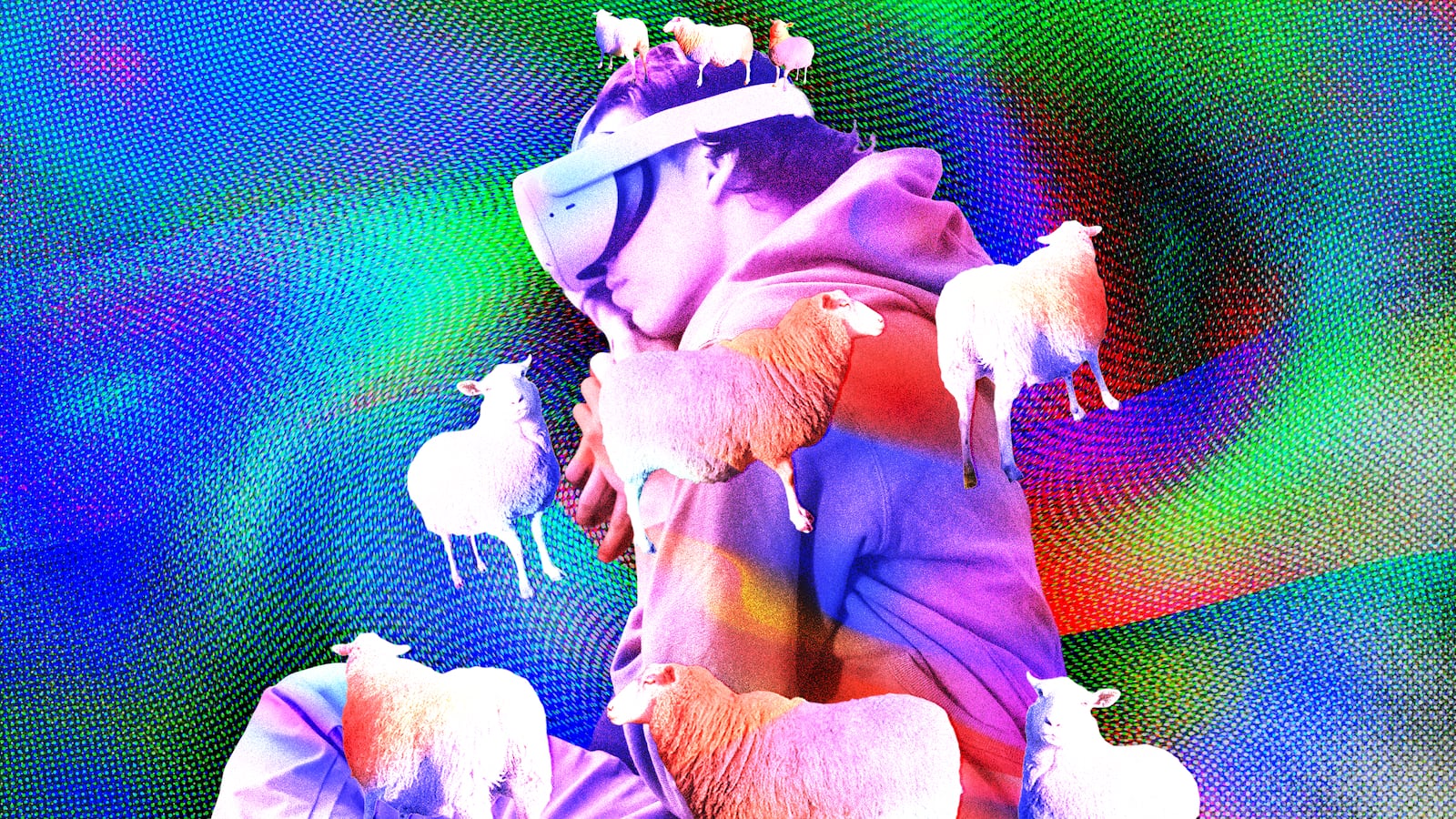You can’t get to sleep. You’ve been tossing and turning for hours. White noise YouTube videos, monotonous podcasts, and Spotify Wrapped-ruining ocean sounds aren’t doing the job for you anymore. You need a stronger sleeping aid.
One community of people online may have the answers to your nighttime woes. Instead of melatonin or white noise machines, they’re turning to a more technological method to help them hit the hay: virtual reality (VR). Using their headsets, they’re loading up a comforting digital world, finding a digital snug bean bag, and catching some Zs.
Most VR sleepers are doing so on VRChat, a metaverse social platform that lets you connect with others and enter user created worlds that range from hang-out spots to immersive art pieces. Many slumber in cozy, ambient worlds specifically designed to sleep in, with bean bags and pillows scattered around the room.
“I can fall asleep alone in my bed in my room or I can fall asleep to the sound and sight of rain hitting the window,” one user told The Daily Beast. “It’s the environment and the feeling of not falling asleep or waking up alone.”

A VRChat user falls asleep on a bed in a digital world. While it may seem odd, the experience isn’t unlike sleep aids like white noise machines, which works for some but not all.
Photo credit: Ryan S. Gladwin. World credit: ZenithValThis experience is so enthralling that many of the users that spoke with The Daily Beast for this story are actively choosing to sleep in VR every night. The combination of the relaxing digital environments coupled with the soothing background noises create a seemingly optimal environment for slumber.
While it may seem odd, the experience isn’t unlike sleep aids like white noise machines, which works for some but not all. Similarly, others report that hitting the hay with their headset on is helping them fight their sleeping difficulties.
“I used to have issues sleeping to where I’d only get three to four hours of sleep at a time," another user said. “A friend eventually suggested trying to sleep in VR and, while I have no explanation for how it helped, I was able to sleep normal hours again after a few months of sleeping in VR.”
Another VRChat sleeper said that they have insomnia, which makes going to bed “stressful.” However, the change in environment from VR helps them “break that stress” to fall asleep much easier. Meanwhile, other users have reported “not feeling safe” in their home so VRChat offers a safe haven for them to catch some Zs.
“Individuals who suffer from insomnia or anxiety disorders, often develop practices that allow them to take their focus off initiating sleep,” Rami N. Khayat, a medical director of University of California Health Sleep Medicine Services, told The Daily Beast. “These individuals may report that engaging in activities such as reading or watching TV or their mobile phones in bed has a relaxing effect and allows them to initiate sleep faster.”
While people are swapping a relaxing book for a VR headset, Khayat warns against the reliance on the technology due to a lack of research on the matter—emphasizing that the medical field doesn't fully understand the effects of mobile phones yet, let alone VR.
“Sleep initiation difficulty is a complex symptom that can be caused by numerous medical, psychiatric, and sleep disorders,” Khayat continued. “As such, while it is possible that VR-based technology may help a group of sufferers, it may equally have adverse effects on others.”
Waking Up in New Worlds (and Bodies)
People aren’t just sleeping in VR due to real-world sleeping difficulties. In fact, some users are simply doing it to deepen their immersion into their virtual avatars. There’s a large community of people on VRChat that are strongly attached with their avatars, such as the trans community who identify more with their in-game avatar than their IRL body due to gender dysphoria.
“It’s oddly calming waking up as your avatar in a new world,” one VR sleeper said. “I don’t know what it is but it just felt…normal when I did it.”
Equally, waking up in a virtual world is part of the attraction. Users can choose to snooze wherever they like from a cozy cottage to outer space. “It’s just nice to fall asleep in a place you never have before, instead of your boring room you see every day,’” another VR sleeper explained. “Felt super weird when I woke up in Minecraft though,” another added.
It's important to remember that sleeping isn’t always a one-person game. Users often sleep with lovers and friends. It’s no different in VRChat, which has sleeping communities that organize on Discord to plan sleep sessions, share pictures of each other sleeping, and provide advice on how to get through the night.
One community, VRC Cuddles, has more than 15,000 members who gather to cuddle and sleep together. Meanwhile a community simply named SLEEP has more than 4,000 members with the sole aim of getting some shuteye in VR.
SLEEP has up to three VRChat worlds online at any time, sometimes with more than 20 people in them—many of whom sleep in these worlds every night. “I’m on a... six-month streak right now," a SLEEP member told The Daily Beast..
Cuddling is a big part of sleeping in VRChat. Some say they can actually feel their avatar being cuddled up to by others through phantom touch, a phenomenon where the brain believes it can “feel” sensations in VR. But for most, simply the presence of another person while sleeping is comforting enough—similar to falling asleep on a phone call to a loved one.

Two digital avatars fall asleep and snuggle up on VRChat. Cuddling is a large component of the VR sleep community—with many users claiming they can "feel" each other via phantom touch.
Photo credit: BuramieThe SLEEP Discord channel is filled with advice on how to survive the night with a VR headset on, including tips like how to prop your pillows to reduce neck strain, loosen the head strap, and adjust brightness settings.
“Exposure to light close to bedtime can directly delay the time the individual is able to fall asleep on the same night and subsequent nights,” Khayat explained. “Electronics such as VR, mobile phones, and TVs remain as a major source of blue light along with other spectra of light. Blue light has been shown to have the most effect on the circadian rhythm, otherwise known as the biological clock.”
This is why it’s recommended that you turn down your brightness and turn on “night mode” which reduces your blue light exposure so as to not negatively affect your current and future nights sleep.
Maybe most importantly, the average headset won’t stay charged for the whole night so you’ll have to keep it plugged in with a 20-watt charger—which isn’t entirely safe.
“The main fire risk with using a VR headset in bed is if the device is covered up in some way, for example if one side of it is resting against a pillow. This can prevent cool air from reaching the hot components, and that can be a real danger,” Steven Athwal, consumer electronics expert and managing director of The Big Phone Store, told The Daily Beast. “Beyond this, there’s an added risk of strangulation from the charging cord.”
Disruptive Sleep
Despite the safety risks, I decided to join the SLEEP community one Wednesday night to see if it was all the VR sleepers made it out to be. I entered the MoonLit Wonderings world, a beach side cottage full of bean bags, beds, and pillows lit by fairy lights and a fireplace.
I found a group of furries napping together shortly before disturbing an eight-foot-tall man in a bed by the fireplace. He turned looking at me with disapproval then rolled over in an eerily realistic way due to his full-body tracking. I decided to switch to another SLEEP hosted world in search of a video player to listen to my favorite sleepy time podcast.

A digital world on VRChat custom designed to ensure that its users have the most comfortable setting for sleep possible. Despite its benefits, using the tech to fall asleep runs the risk of further disrupting sleep due to blue light exposure.
Photo credit: Ryan S. Gladwin, World Credit: WispyWoo / MoonLit Wonderings, bed by the fireplace.The headset was uncomfortable on my face despite all the tips and tricks the Discord had given me. It took an hour and a half of tossing and turning before I fell asleep.
When I woke, I spent a moment moving my hands in front of my face. The hand tracking working as soon as I woke deepened my immersion. I assumed it was morning but had no natural indicators as the sun doesn't rise in sleeping worlds. But when I checked the time to see 4:56 a.m.—less than four hours after I’d fallen asleep—I scoffed, threw my headset off and got some real shuteye.
“That’s a common experience,” VR user Jaeger laughed. “As with many things in VR, the more you do something the more comfortable it gets. Give it a couple more shots, maybe it’ll work the third time.”








